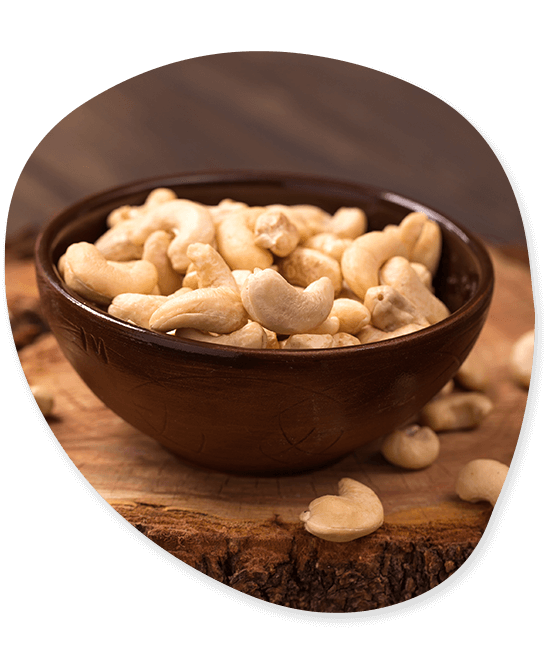Cashew
The Anacardiaceae family includes the medium-sized tropical evergreen tree known as cashew. Typically, this tree is grown for its curled edible seeds. Around 61 countries around the world receive cashew exports from the Indian cashew nut exporter. Around 41.64 USD million is the total value of India’s cashew nut exports. Vietnam, the United States, Malaysia, the United Arab Emirates, and Norway are the top five international buyers of cashew nuts from India. Numerous product variations are exported from India together with cashew nuts.

Nutrients:
- Calories – 48 calories
- Dietary Fiber – 3.3 g
- Carbohydrate 11 g
Minerals:
- Calcium
- Iron
- Magnesium
Vitamins:
Protein:
Pre-Shipment Inspection:
Standard Packing:
- We provide packaging in terms of 5, 10, 20, 25, 50 and 100kg also, as per the customers’ (country) requirement.
CASHEW VARIETIES WE EXPORT
The cashew nuts imported from India come in a number of different types, including BPP-1, BPP-8, VRI-1, and others. The Indian exporter of cashew nuts ships their high-quality nuts to different parts of the globe. The following are the main kinds of cashew that are exported.

BPP-1
This variety is a cross between Tree No. 1 and Tree No. 273, with Tree No. 1 serving as the female parent and No. 273 serving as the male parent. The 1980 saw the release of the BPP-1 variety. This cultivar often produces 10 kilogrammes or less per tree. The size of the Nuts is medium, with a nut weight of approximately 5g and a shelling percentage of approximately 27.5.

BPP-8
The BPP-8 type It is an offspring of the cross between Tree No. 1 and Tree No. 39. This variety was released in 1993 for general cultivation in Andhra Pradesh. In Orissa and West Bengal, the BPP-8 variety has been functioning admirably. The other six types derived from Bapatla are thought to be inferior to this variety.

VRI-1
A selection of the Vazhi Sothanai Palayam germplasm in Tamil Nadu’s South Arcot District produced the VRI-1 variety. This type produces a medium-sized tree with 5–7 fruits per panicle on an average. The average yield of VRI-1, which was introduced in 1981, is approximately 7.2 kg/tree under Vridhachalam conditions. This variety’s nuts weigh only 5g and have a shelling percentage of roughly 28%.

VRI-3
The VRI-3 was introduced in 1991 and is a seedling progeny of a high producing tree that was gathered from the village of Edayanchavadi in Tamil Nadu’s South Arcot District. The yield of VRI-3 is about 10 kg/tree. This variety’s nuts have a medium size, weigh 7.2g, and have a shelling percentage of roughly 29.1%.

BHUVANESHWAR
The WBDC V (Vengurla 36/3), a collection from the Regional Fruit Research Station, Vengurla, produced the seedlings from which the Bhuvaneshwar was chosen. This variety, which was introduced in 1989, has a flowering season that lasts roughly 70 days and occurs from January to March. With roughly 12 fruits per bunch, this cultivar bears in clusters.

BALABHADRA
Early flowering (Dec-Feb) cultivar with robust nuts weighing about 7.4 g, the Balabhadra. The typical nut production from this variety is 2.0 t/ha (10.0 kg/tree). Additionally, this cultivar has a high shelling rate of roughly 30.0%.

JHARGRAM-1
The Jhargram-1 is a subsample of T.No.16, which was first gathered in Bapatla. It was introduced in 1989 and has an extensive branching habit and a medium-compact canopy. It typically bears 6 fruits per bunch and produces 8.5 kilogramme of small-sized nuts per tree. This particular type has a shelling percentage of about 30%.

JHARGRAM-2
The Jhargram-2 is a selection from the H-2/15 seedling plantation at the West Bengal Regional Research Station. This variety blooms in the middle of the season and produces 3–4 fruits per panicle. This variety’s average nut weight is roughly 9.2g, with a 2.85g kernel weight and a 32% shelling percentage.




VENGURLA-1
The Vengurla-1 is a selection made from germplasm gathered in Maharashtra’s Ansur village’s Vengurla Tehsil. The typical proportion of flawless flowers in this cultivar, which was introduced in 1974, is roughly 8%. Vengurla-1 has an average yield of about 19 kg per tree. This variety’s nuts weigh about 6.2g and have a 31 shelling percentage.
VENGURLA-8
A hybrid type of cashew nuts called the Vengurla-8 was introduced in 2001. This cultivar produces between 15 and 20 kilogramme per tree. The Vengurla-8 has large nuts, averaging 86 nuts per kilogramme. The red apple variety has an 85% juice recovery rate.
BALLI-2
The ICAR Research Complex in Goa produced and released the Balli-2 variety in 1999. This is the first Goan-produced cashew cultivar. Balli-2 produces an average yield of 7.0 kg per tree, with an average nut weight of 7.6 g and a shelling percentage of 30.0%.
TISWADI-3
The ICAR Research Complex in Goa created and released the Tiswadi-3 variety in 2007. This pick is from the Ela village in the North Goa District’s Tiswadi taluk. This variety has an average output of 5.5 kg per tree, with an average nut weight of 9.4 g and an average shelling percentage of 29.25.
Vachhani Impex is the major Cashew Nuts importer from India. At Vachhani Impex, we are aware that exporting can occasionally be a challenging procedure. From the first documentation to the last product delivery, our experts will assist you with every stage of the export procedure. If you’re looking for a cashew nut exporter, get in touch with Vachhani right away!
